Art in the Age of Climate Crisis: Making Questions
2021 Artists’ Residency at Arts Farm Tutbat—Climate Change
_Jeeyeon Kim, artist
From transition
The theme of the second Artists’ Residency at Arts Farm Tutbat—Climate Change program this year was “transforming perspectives, ways of viewing the world.” Transforming! I have an intimate connection with the word, which is a key concept in the response to climate change. Twelve years ago, I was in charge of daily research reports at an institute concerned with climate change issues in Asia. I also organized two international workshops in Vietnam and Korea on the topic of “climate change adaptation,” working with people from various fields to develop climate change scenarios that aimed to predict the future using lectures on associated topics by scientists. My various activities related to climate change led me to write a master’s thesis on the United Nations Framework Convention on Climate Change (UNFCCC), and visit Transition Town Totnes in England as part of a two-year field research period during which I studied ecological communities in Korea and overseas. This residency saw me encountering climate change once again, this time in Hwacheon as an artist.
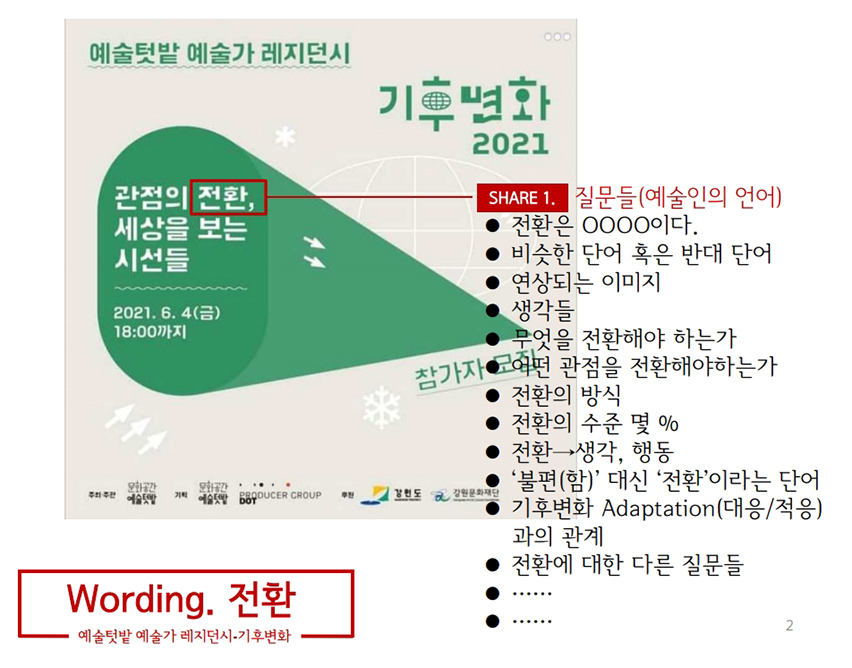 |
Share 1. Questions (the language of artists) ● Transformation is ____. ● Similar words and opposites ● Associated images ● Ideas ● What needs to be transformed ● What perspectives should be shifted ● Methods of change ● Levels of change (percentage) ● From change to thoughts and actions ● "Change" instead of "discomfort" ● Our relationship to climate change adaptation ● Other questions about change |
No longer “climate change,” but “climate crisis”
The three sessions of joint research conducted by the Hwacheon artists in residence included seven lectures that addressed climate change in Hwacheon and six screenings of documentaries on the environment. The research showed how much the climate situation has declined compared to 12 years ago—it is no longer a matter of “climate change,” but one of “climate crisis.” What sort of things happened in those 12 years?
In terms of the effects of global warming in Korea, team leader Byun Young-Hwa of the National Institute of Meteorological Sciences (NIMS) noted that minimum temperatures are rising faster than maximum temperatures, and such changes are apparent in winter rather than summer. The cancellation of the Sancheoneo Ice Festival due to warm weather two years ago was closely related to global warming. Byun also explained that the causes of global warming lie in human activity—a fact that is also clearly pointed out in the Sixth Assessment Report of the Intergovernmental Panel on Climate Change (IPCC), which was published the very next month on August 9.
As I read through the various examples of ecosystem diversity being damaged as cited by biologist Park Byung-sang, the immense influence human activities have on ecosystems became apparent. Having destroyed some species and given rise to other new ones, humans now presume to intrude on the province of God as “Homo deus.” So ashamed did I feel over what humans have become that I found myself wanting to declare my own species “disqualified.” Confronted with these changes in nature—the death of extremely beautiful coral reefs, the cumulus clouds and frequent sudden bursts of rain I saw in Southeast Asia, and this year’s pink-hued, twilit skies that seemed so surrealistically beautiful—I felt, to borrow words from Kim Cho-yeop’s Greenhouse at the End of the World, like I was “becoming someone who could no longer simply marvel at the beautiful landscapes before me.”
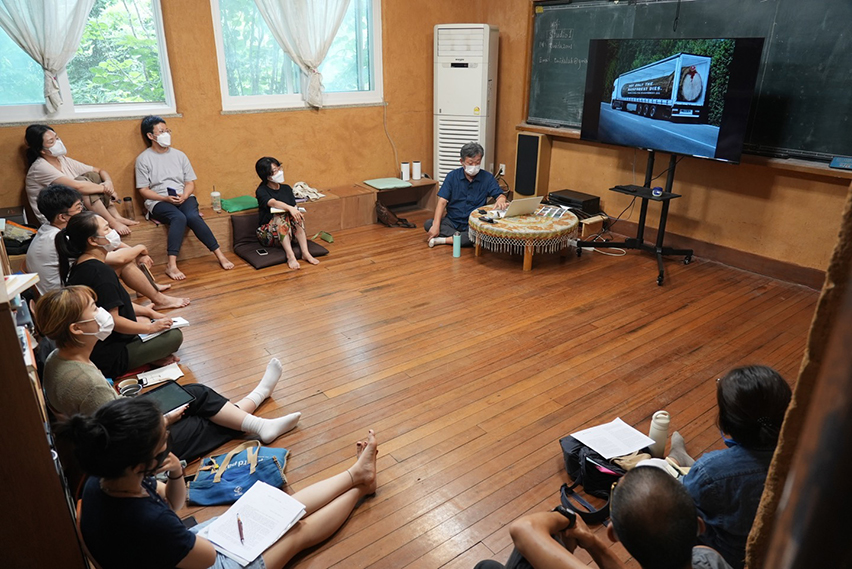
Joint research invitational lecture
At the COP26 event in Glasgow on November 8, 2021, a government minister from the South Pacific island nation of Tuvalu delivered a speech calling for a response to climate change; he was broadcast standing knee-deep in water on his country’s coast. Indeed, while climate change is a shared issue confronting all of humankind, the matter of climate inequality and the fact that the crisis does not affect everyone equally have been rising to the fore. While most approaches to the crisis have been from an ecological perspective, The End of the Carbon Society by Cho Hyo-je, a SungKongHoe University social sciences professor who approaches the climate crisis from a human rights and society perspective, and Becoming a Minority by Ecosophialab director Kwon Heechung expanded this into a social approach, presenting the idea that our response to climate issues should proceed in tandem with the creation of just and equal societies.
House of Aesthetics director Lim Jiyeon emphasized the importance of field-centered research and knowledge as experience. When knowledge gets us working in different ways above and beyond the desire to “know,” this can translate into methods of living and doing during the climate crisis. I found myself thinking of the author Peter Wohlleben, who published a book of his thoughts and experiences from working as a forest analyst. Speaking from a perspective that emphasized nature’s inherent resilience, he inspired me to view trees, forests, and nature in a different way—as one TV show producer put it, “Forests weren’t the forests I knew.” It seemed like I needed to start to break free from my anthropocentric perspective and understand nature in a new way—right now.
Natural plant consumption: A small form of practice in everyday life
| There was also a lecture by Lee Euicheol from the Vege Doctor, an organization of medical professionals who are vegetarians. Attending his lecture on the topic of “vegetarianism and climate change,” I learned about the enormous CO2 emissions that arise from the raising of livestock (especially the methane gas produced by livestock) and production of their feed; I also learned about the suffering of animals in today’s factory-style livestock environment. I sensed the need for humans to reduce our meat consumption to escape this unhealthy cycle. Making the decision to put what we learned into practice, the other resident artists and I resolved to try a natural, plant-based diet for two weeks on our own schedules. Ordinarily, a natural, plant-based diet forbids the consumption of food from six categories—meat, fish, dairy, eggs, sugar, and oil—but we were allowed one exception. Deciding that if I were going to do it, I ought to do it right, I made the bold choice to ban foods from all categories. This left me with almost no options for eating outside of my home. And since I don’t cook, I was left with |
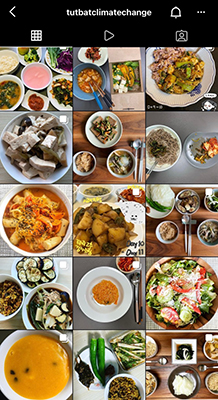 2주간 도전! 자연식물식 식단 |
| even fewer choices. Subsequently, I was forced to adhere to a “passive” natural diet in which I muddled through my two weeks eating things like corn, sweet potatoes, bananas, and other fruit. Even so, I found my body and mind feeling better than ever. Using the residency’s official Instagram account(@tutbatclimatechange), we shared our daily menus, our recipes and tricks, and the physical and mental changes we were experiencing. For a while, we were uploading so many vegetarian recipes that one might have confused the account for a food site: we posted dishes like vegetarian dumpling soup, vegetarian curry, grilled vegetables, and more. We were becoming evidence of our own hope. “It feels like I’m filled with nature.” “This is my first time buying zero-waste items. My life is changing.” “The food didn’t have any oil, so when I washed the dishes, I only needed to rinse them with water without using soap.” Serving the environment and benefiting the Earth and ourselves was more than just an uncomfortable experience. Changing our diets was our first step toward changing our lives. | |
A sense of connection: Person to person, people to nature
From June to November, the planning and archiving teams worked together with seven artists active in the fields of theater, multidisciplinary arts, visual arts, and film. It was truly rewarding to have colleagues with whom to share the topic of climate change. Our joint research schedule was flexible, actively reflecting the ideas and suggestions of the artists. There were also three collaborative workshops organized by the participating artists themselves.
Big Picture by artist Kim Yeong-kyeong drew on all of the residents’ imaginative capabilities to complete a portrait of climate change, becoming a process akin to developing a “script” for climate change. As I witnessed each of the artists continuing and adding to the picture, I sensed how we were all holding on to hope, no matter what sort of future we envisioned. Collective Experience by Yoon Jong-yeon, which involved activities intended to form an instantaneous community, used the body and gestures to provide a sense of why we need to stay connected amid the climate catastrophe.
While Kim and Yoon focused on the connections that bind people together in the climate crisis, artist Park Eun-ju focused on our connections with nature in Hiking at Night. As a participant, I walked in silence through pitch blackness, without a single streetlight in sight. The black-and-white nightscape seemed unreal, as though I had been placed into a world from which all color had vanished. It felt like entering an ink-wash painting or becoming part of nature and walking inside of it. Deep in the forest, the distant sounds of birds, flowing water, and other noises seemed very close, but the entire setting also felt like it was filled with the sounds of grass insects and other creatures I could not easily discern.
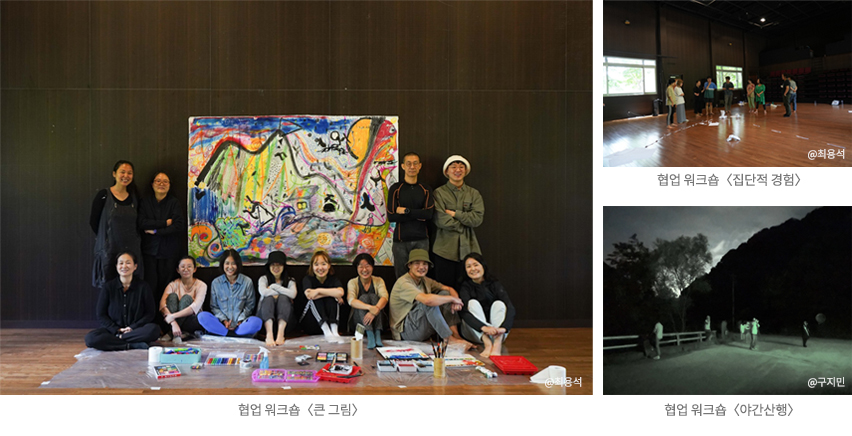
(Clockwise from left) Big Picture collaborative workshop, Collective Experience collaborative workshop,
Hiking at Night collaborative workshop
Time spent combining ideas and working
When we were away from Hwacheon, we met online to continue sharing ideas and questions. This was the “online meeting” component of the residency, in which individual artists chose topics to research, share, and discuss. This year’s online meeting was an active opportunity to share individual research and the artists’ “Open Tutbat” work. Due to this, I would obviously like to talk about the artists’ exhibited work as well.
From our vantage point in the midst of the climate crisis, addressing the topic of “climate change” proved more difficult than expected. Indeed, it remains difficult even now. Not only does the term itself encompass the entire Earth, including its atmosphere, but as artist Lee Seong-jik noted, the associated language all feels quite vast. Those of us who feel at a loss regarding where or how to begin are met at first with desolation, frustration, and helplessness. We are living now in a “post-truth” era in which people are deeply at odds over the issue of climate change; additionally, there is also a sense that the marketing issue of “greenwashing” is clouding our judgment and confounding our responses.
In her work, artist Lee Hakyeong developed a film script based on the story of those of us caught in the middle of the climate crisis. With its trenchant and incisive questions that went a step beyond to examine how we can change the way we live our lives, it shares the apparent message that we cannot go on living today without changing our lives.
Artist Koo Jimin shared her concerns as an individual living in the climate crisis alongside admissions of cognitive dissonance in her work as an artist. Along those lines, she posed five questions. Since July 2021, Ku has been publishing the Naver webtoon series Climate Crisis Person, addressing everyday aspects of climate change in order for the public to easily relate to it. For this exhibition, she shared the webtoon’s protagonist, a figure known as koohie. Ku is living proof that the issue of climate change is already inextricably linked to artistic work and the ways individuals live.
I restricted my work to Hwacheon, focusing on the ways in which we experience climate change through local phenomena, perceptions, and behavior. In particular, I conducted interviews with Hwacheon residents to see how the climate crisis has been influencing their thoughts, feelings, and decisions; I also passed the camera along to participants so give them an opportunity to think about the topic as they walked through Hwacheon. To allow for a multilayered experience of the results of my research on Hwacheon in a climate change context, I reinterpreted them in terms of four approaches: “LabNote,” “Blending Coffee Hwacheon,” “Eco-Branding,” and “Climate Fiction.” With “Blending Coffee Hwacheon” in particular, I wanted to show how coffee—an industry whose very existence is being threatened due to declining cultivating areas and yields amid the effects of global warming—represents another form of local (farming) crisis caused by climate change.
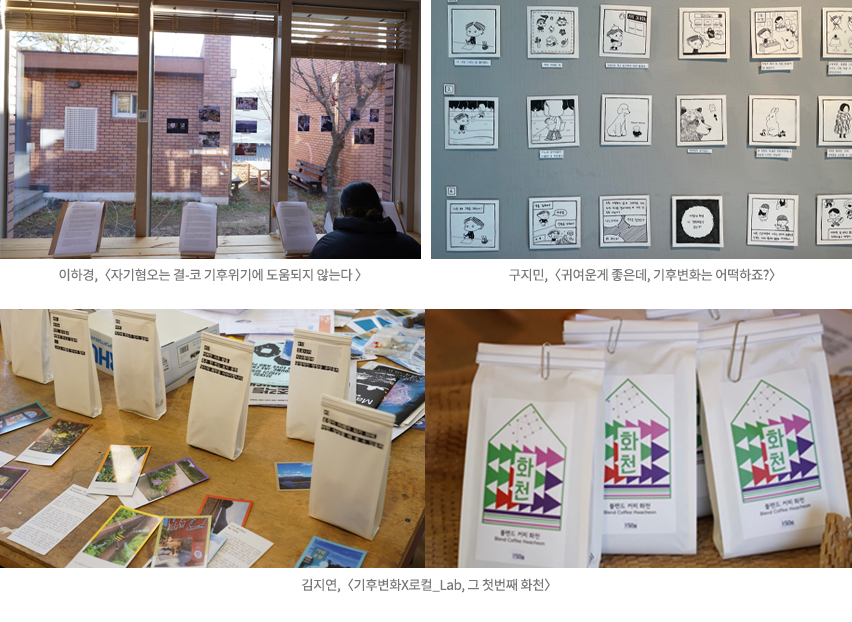
Lee Hakyeong, Self-hatred Never Helps the Climate Crisis
Koo Jimin, I Like Cute Stuff, but What Do I Do with Climate Change?
Jeeyeon Kim, Climate Change X Local: Lab #1. Hwacheon
An unseen world that we have willfully ignored
Kim Youngkyung began her story with Peter Wohlleben’s books The Secret Network of Nature(DAS GEHEIME NETZWERK DER NATUR)and The Hidden Life of Trees(Das geheime Leben der Baume). Trees are social entities that use microorganisms and roots to exchange information and share nutrients—not only with their fellows, but also with potential foes. The world of trees holds many implications for humankind. The long-awaited picture book Northern Spruce is a story about trees, forests and the children living in two villages that is based on a newfound sense of wonder at an unseen world.
In Let’s Birding! by Lee Seong-jik, two forms of “birding” take place at the same time: one is birdwatching, and the other is a reinterpretation of the word “birding” to mean “the things a bird does.” This attempt to understand birds through physical movements is a response to our need to consider how human and nonhuman beings are interconnected for the sake of coexistence. It also aims to reestablish our relationship with nonhuman beings amid the climate crisis so that we can truly become a community.
Given the close relationship between climate change and our atmosphere, artist Park Eunju’s Gas Theater uses the body’s senses and imagination to measure the air—something that clearly exists yet goes unperceived. This work encourages viewers to consider how we can make the invisible (such as hidden things, shadows, and problems) visible in the area of climate change.
World in Motion by Yoon Jongyeoun can be interpreted in two different ways: first as a story about microorganisms, and second as a story of the people in this world who are most vulnerable to and bear the brunt of climate-related disasters. Yoon repeats the words “I didn’t agree before…” several times, forming a message that resonates deeply and comes across as a desperate cry from those who remain without a voice in the climate crisis.
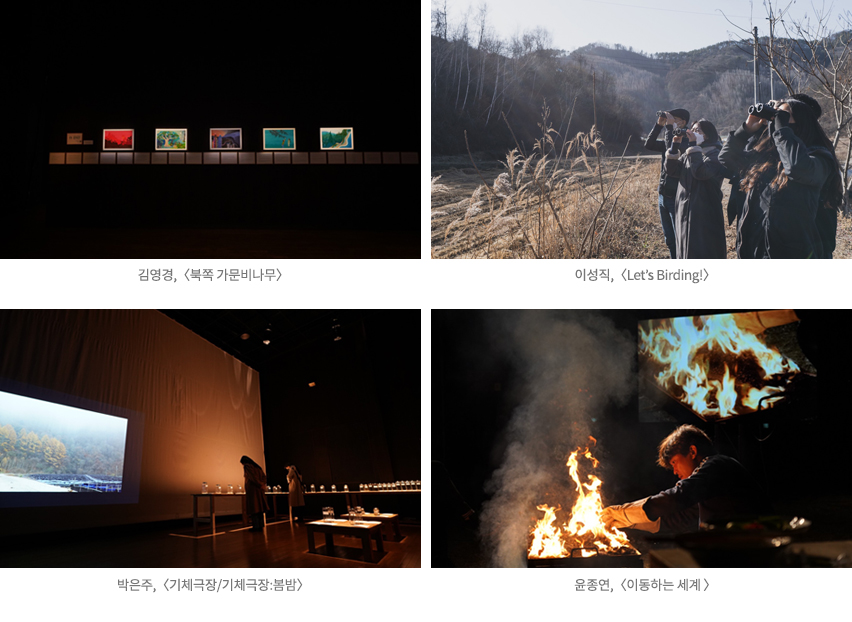
Kim Youngkyung, Northern Spruce / Lee Seong-jik, Let’s Birding!
Park Eunju, Gas Theater / Yoon Jongyeoun, World in Motion
Hwacheon’s time and space: A forum for a climate change discussion
Participants encountered Hwacheon’s nature both together and individually. With its pristine, undisturbed natural areas, Hwacheon is an example of the path that we need to follow: that of an “old future.” While staying in Hwacheon for my individual research, I woke up to the morning sunlight and the twittering of birds; at night, I fell asleep looking at the stars and listening to the sounds of grass insects. As my daily life became attuned to nature’s clock, my mind and body started to feel lighter; as I observed nature instead of my cell phone, I gained a sense of mental freedom and an opportunity to focus fully on myself. The experience was so vastly different from my life before that I became confident that I could write my own Walden, just like Thoreau. I saw magical moments like the mountains disappearing into the fog before my eyes. Every night, I saw the Hwacheon skies fill with meteors, galaxies, and stars that seemed like they might come raining down at any moment. But I could not simply stand before those moments and marvel—for Hwacheon is not exempt from the effects of climate change. Two years earlier, it experienced climate change firsthand when it was forced to cancel the Sancheoneo Ice Festival due to unseasonably warm winter weather. In that sense, Hwacheon has felt an even more acute sense of alarm over climate change than other regions.
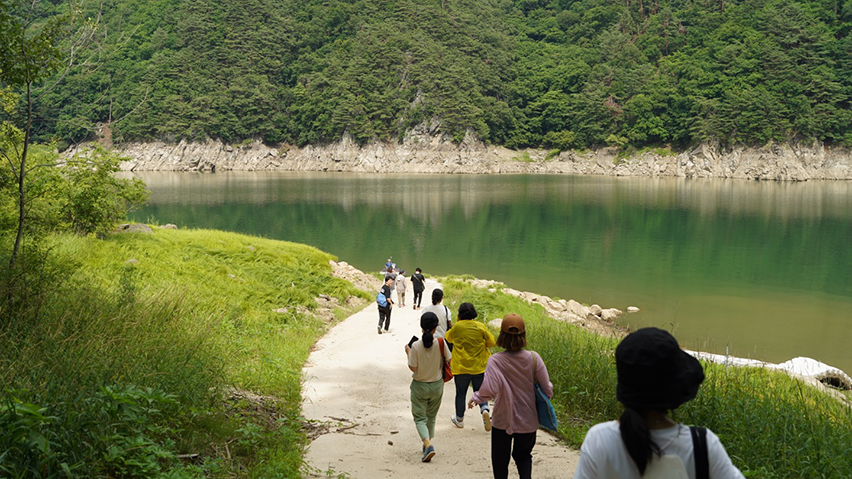
Joint research Hwacheon tour
Continuing for its second consecutive year in 2021, the residency on climate change in Hwacheon has been establishing a sense of place as part of a public sphere on the climate change issue. The COVID-19 pandemic continues, but this year’s Open Tutbat program was able to take place with the participation of many local residents and other visitors, sharing the results from the residency. In the process, we have begun to share collective memories through our common experience of climate change in Hwacheon, and the natural environment of Hwacheon will continue to play its part in adding resonance to the climate change debate. In the not-too-distant future, we can imagine the arrival of a new kind of school in Hwacheon: a climate art school. Hopefully our shared experiences and memories will provide some small support when that time comes.
“Art is a questioning of issues”/”Art creates questions”
With the COVID-19 pandemic, we have encountered an utterly unexpected turn of events. At the same time, we are also facing the urgent situation of climate change. Once again, we have started to feel the pressure, and because of the extreme measures undertaken with the imperative to make tangible change here and now, we have experienced various developments that are unhelpful in solving our problems. Now that we have entered an uncertain era, focusing solely on “right answers” is no longer a valid approach. Responding to uncertainty requires a perspective of resilience—the ability to roll with the punches and flexibly respond to every kind of change. This is something we will find not in “right answers,” but in questions. Questions do not just help us to discover problems and develop the ability to resolve them; they also provide us with hints about what sort of society we should be creating in the future. So who will be able to ask the questions when it comes to the climate crisis? As a researcher myself, I would say it is art and artists. John Maeda once said, “Design is a solution to a problem. Art is a question to a problem.” As art responds flexibly to uncertainties, it becomes a medium that leads naturally into what comes next. The questions that artists ask, combined with artistic imagination, provide the power to build a better future. The conclusion that I reached through my residency experience is that the role of art in the climate crisis is to create and share questions. I would like to invite all of you to our Online Forum in January 2022. In this setting, we came to view the issue of climate change in new and different ways as questions invited other questions, and old questions joined new ones.
Artists’ Residency at Arts Farm Tutbat—Climate Change homepage
http://artstutbatclimatechange.com
@tutbatclimatechange (Artists’ Residency at Arts Farm Tutbat—Climate Change instagram)
Jeeyeon Kim focuses on the invisible―connection, relationships, and placeness―as a way of restoring communities. Rather than fixating on the existing communal ways, she conducts urban and future-oriented experiments, exploring the members and placeness of communities for a broader interpretation of communal possibilities. Particularly concerned with the placeness of cities, Kim designs and executes various social experiments through which a space can serve as a communal base where social relationships are formed.
jeeyeonkim1@gmail.com








 PREV
PREV
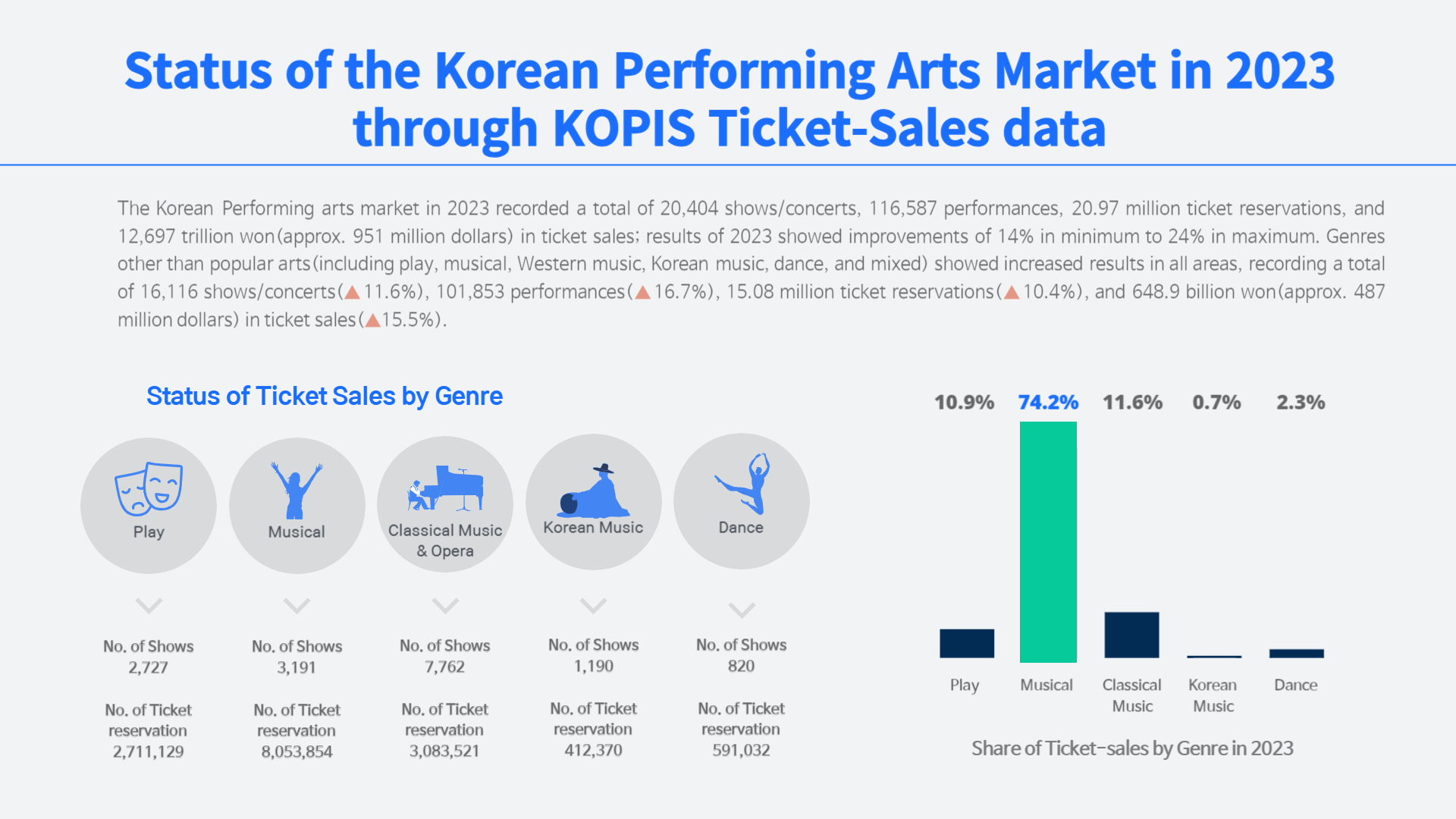
.jpg)
.jpg)
.jpg)
.jpg)











